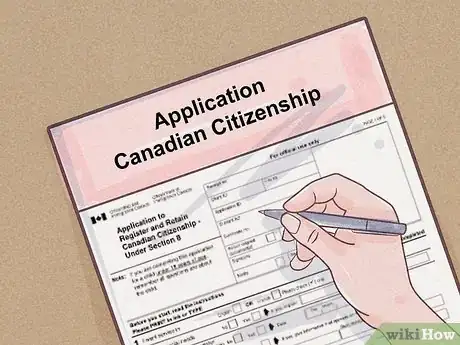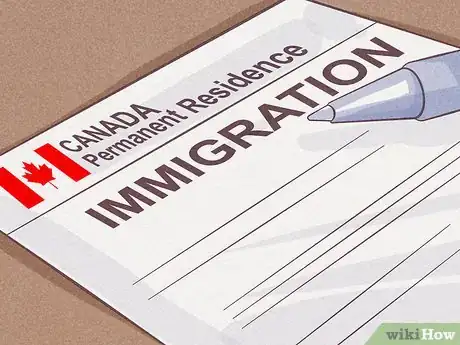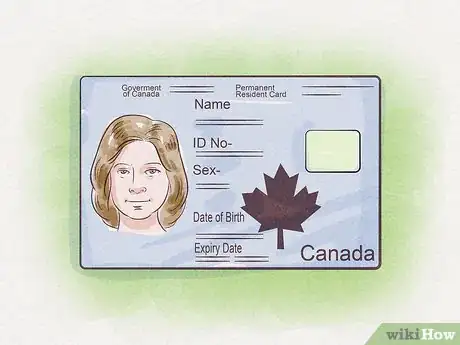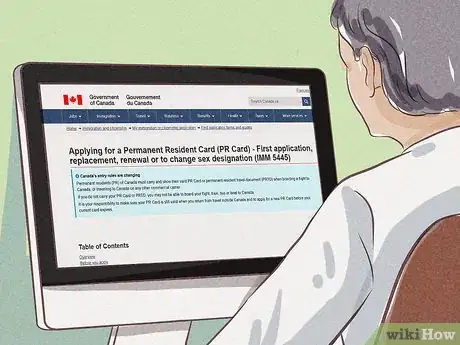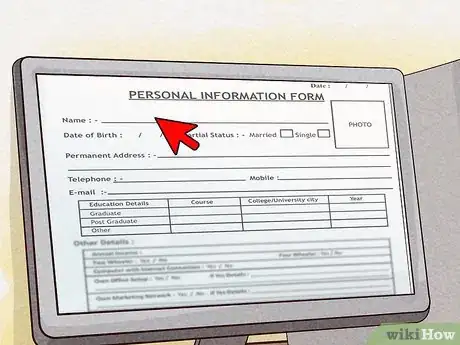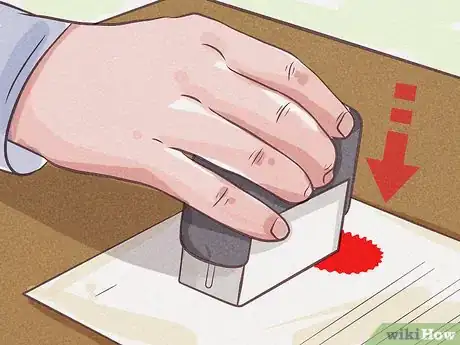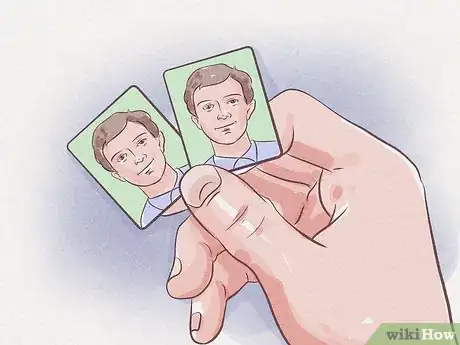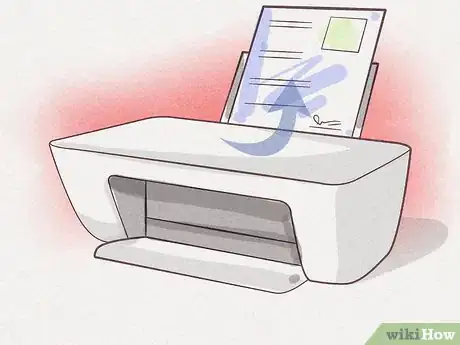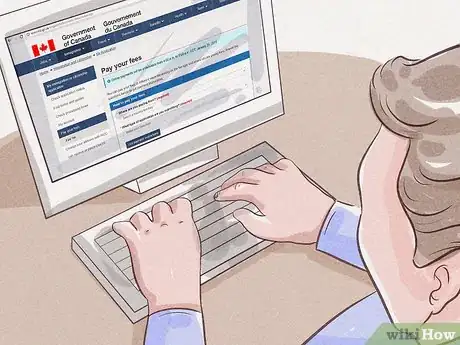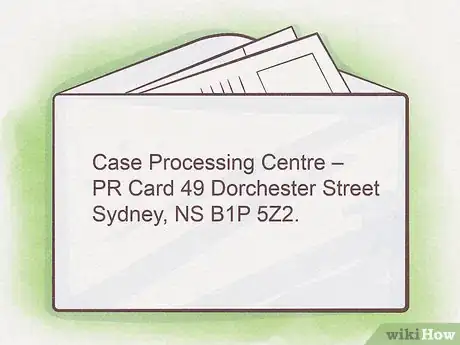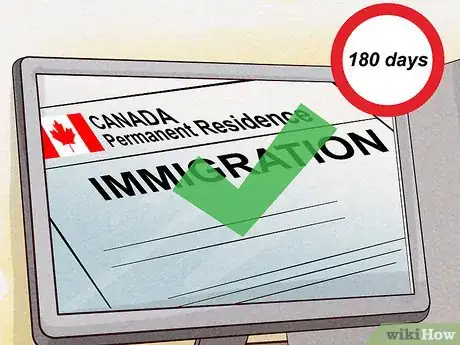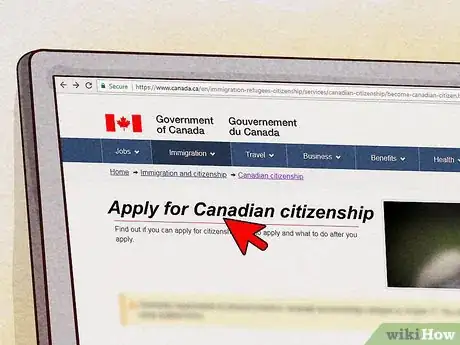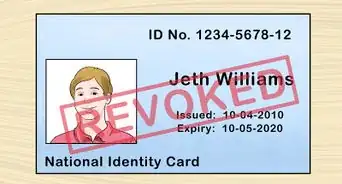This article was co-authored by Timothy Morson. Timothy Morson is a Canadian Immigration Specialist and a former Canadian Diplomat. With over 30 years of experience, Timothy specializes in Canadian immigration programs, immigration management, employer compliance, and international mobility. He holds a BA in Political Science from Concordia University and an MA in Journalism from Western University. Timothy is accredited by the Immigration Consultants of Canada Regulatory Council (ICCRC), Immigration Quebec, and is a member of the Order of Chartered Administrators of Quebec (Adm.A). He works to help people and companies around the world achieve their immigration goals.
wikiHow marks an article as reader-approved once it receives enough positive feedback. In this case, 94% of readers who voted found the article helpful, earning it our reader-approved status.
This article has been viewed 59,420 times.
Applying to be a permanent resident in Canada will allow you to live, work, and study in Canada legally for a prolonged period of time. Having permanent residence status in Canada can also make it easier for you to apply for Canadian citizenship so you can stay in Canada indefinitely.[1] To apply for permanent residence, you will need to confirm you are eligible and complete the application in full. If your application is approved, you will receive your Permanent Residence (PR) card in the mail to prove your status in Canada.
Steps
Confirming Your Eligibility
-
1Apply for permanent residence if you want to stay in Canada indefinitely. Permanent residence is a good option for students or temporary workers in Canada who want to stay in the country permanently. Permanent residence allows you to access basic social services in Canada like healthcare. It also makes it legal for you to live and work in the country. As a permanent resident, you do not have to give up citizenship in other countries, allowing you to still have legal ties to your homeland.
- Permanent residency is also a good first step to applying for citizenship in Canada if you plan to do so in the future.[2]
-
2Register a claim with the government first if you are applying as a refugee. Once your claim is approved by Canada's Immigration and Refugee Board, you can apply for permanent resident status. Most refugees who have been resettled to Canada become permanent residents through refugee assistance programs run by the Government of Canada. You may be told to apply for permanent residence by a government resettlement representative once your refugee claim is approved.[3]
- The Immigration and Refugee Board may be able to help you apply for permanent residence to make your transition as a refugee easier. Contact a representative on the Board for more information.
Advertisement -
3Remain in Canada while you complete the application. The application for permanent residence must be done while you are living in Canada, as it cannot be done while you are living in a different country. You will need to stay in Canada once you complete the application so you can receive your Permanent Residence (PR) card.[4]
- As a permanent resident, you can leave Canada at any time as long as you carry your PR card with you. You cannot spend more than 2 years abroad, as this can cause you to lose your permanent resident status in Canada.
Applying for Permanent Residence
-
1Consider finding a representative to help with the application. A representative is a person who offers advice and guidance on your application. They can also make legal arrangements and advocate on your behalf during the application process. If you use a representative, you will need to note this on your application and provide their contact information.[5]
- Representatives can be uncompensated, such as a lawyer working pro bono or a friend or family member who helps you fill out the application. You may go for a compensated representative like a lawyer or legal advisor you pay to help you if you have the funds.
- Keep in mind you are not obligated to use a representative to complete the application and it is not required to process your application.
-
2Apply online through the Government of Canada website. The application contains 26 questions that must be answered in full. If a question does not apply to you, write “Not applicable” or “N/A,” rather than leave it blank. Download and complete the application on a computer so you can type your responses. You will need to submit the completed application with the other required documents.
-
3Provide basic personal information. You will need to disclose your full name, your gender, and your date of birth. You will also to provide your country of birth and any countries you are currently a citizen of, as well as your mailing address in Canada and a telephone or email you can be reached at.[6]
-
4Disclose information on your work, travel, and education history. You will need to list this information covering the past 5 years. Include a detailed list of your travel to locations outside of Canada, including any short trips or trips while employed. Note the names and locations of your employers for the past 5 years, even if you were self-employed. List the names and locations of educational institutions, colleges, and universities you attended within the past 5 years as well.[7]
- Try to be as detailed as you can in these sections and put in as much information as you can remember or track down. If you are not sure about any section, consult a representative for guidance. Do not leave any of these sections blank, as this can negatively affect your application.
-
5Include certified copies of your travel documents. If you have already claimed refugee status, you can use the travel document given to you by the Canadian government or the Minister of Immigration. The document should include your full name, your date of birth, a document type and number, and an issue and expiry date.[8]
- If you do not have a travel document from the Canadian government, you can use any identity document that was issued to you in a country outside of Canada before you arrived in the country.
- The copy of the travel document must be certified by a notary public or a commissioner of oaths. Look for one in your area or ask your representative for a referral to one.
-
6Provide 2 photographs of yourself. The photographs must be taken within 6 months of your submission of the application. Make sure the photographs follow the guidelines for government issued documents and that they are identical. Place the photographs in an envelope and write your name on the envelope.[9]
-
7Print, date, and sign the application. Once you have completed the application, print it off on white, non-glossy paper. Make sure it is legible and easy to read. Then, sign and date the application to indicate everything in the application is true and correct.[10]
-
8Pay the $50 CAD processing fee for the application. You can pay the fee through online banking or a credit card if you have a Canadian bank account. You can also pay with certified cheque or money order.[11]
- Look up the different ways you can pay for the processing fee based on the country you are a citizen of online here: http://www.cic.gc.ca/english/information/fees/index.asp.
-
9Mail your application to the Case Processing Centre. Make sure you include the required supporting documents with the completed application. Mail the documents to: Case Processing Centre — PR Card P.O. Box 10020 SYDNEY, NS B1P 7C1 CANADA.[12]
- If you are sending in the application by courier, send it to: Case Processing Centre – PR Card 49 Dorchester Street Sydney, NS B1P 5Z2.
Receiving Permanent Residence
-
1Provide a Canadian mailing address. You will receive a message at the email you provided on your application confirming your application has been received and is processing. Once you have been approved, your PR card will be sent to you in mail within 180 days of submitting your application. [13]
-
2Contact the Government of Canada if you do not receive your PR card. If you do not receive your PR card within 180 days, reach out to a representative to find out the status of your application. Your application may be denied if it is incomplete or you are missing specific documents. It may also be turned down if the photos you provide are not up to government standards.[14]
- If your application is denied, you can reapply. However, you will need to pay the application fee again.
-
3Renew your PR card before the expiry date. Most PR cards last for 5 years, though some may only be valid for 1 year. Make sure you apply to renew your card before it expires, especially if you plan to travel outside of Canada. You will need to pay the processing fee again and provide the necessary documentation to get a new card.[15]
- Most people with a PR card will try to apply for Canadian citizenship before their card expires. This way, they can have a more permanent status in Canada and do not have to worry about renewing their PR card.
Expert Q&A
Did you know you can get expert answers for this article?
Unlock expert answers by supporting wikiHow
-
QuestionDo I need to apply for permanent residence if I want to become a Canadian citizen?
 Timothy MorsonTimothy Morson is a Canadian Immigration Specialist and a former Canadian Diplomat. With over 30 years of experience, Timothy specializes in Canadian immigration programs, immigration management, employer compliance, and international mobility. He holds a BA in Political Science from Concordia University and an MA in Journalism from Western University. Timothy is accredited by the Immigration Consultants of Canada Regulatory Council (ICCRC), Immigration Quebec, and is a member of the Order of Chartered Administrators of Quebec (Adm.A). He works to help people and companies around the world achieve their immigration goals.
Timothy MorsonTimothy Morson is a Canadian Immigration Specialist and a former Canadian Diplomat. With over 30 years of experience, Timothy specializes in Canadian immigration programs, immigration management, employer compliance, and international mobility. He holds a BA in Political Science from Concordia University and an MA in Journalism from Western University. Timothy is accredited by the Immigration Consultants of Canada Regulatory Council (ICCRC), Immigration Quebec, and is a member of the Order of Chartered Administrators of Quebec (Adm.A). He works to help people and companies around the world achieve their immigration goals.
Canadian Immigration Specialist
-
QuestionHow do I qualify for permanent residence in Canada?
 Timothy MorsonTimothy Morson is a Canadian Immigration Specialist and a former Canadian Diplomat. With over 30 years of experience, Timothy specializes in Canadian immigration programs, immigration management, employer compliance, and international mobility. He holds a BA in Political Science from Concordia University and an MA in Journalism from Western University. Timothy is accredited by the Immigration Consultants of Canada Regulatory Council (ICCRC), Immigration Quebec, and is a member of the Order of Chartered Administrators of Quebec (Adm.A). He works to help people and companies around the world achieve their immigration goals.
Timothy MorsonTimothy Morson is a Canadian Immigration Specialist and a former Canadian Diplomat. With over 30 years of experience, Timothy specializes in Canadian immigration programs, immigration management, employer compliance, and international mobility. He holds a BA in Political Science from Concordia University and an MA in Journalism from Western University. Timothy is accredited by the Immigration Consultants of Canada Regulatory Council (ICCRC), Immigration Quebec, and is a member of the Order of Chartered Administrators of Quebec (Adm.A). He works to help people and companies around the world achieve their immigration goals.
Canadian Immigration Specialist To get permanent residence, you'll have to find an immigration program that's appropriate for your situation. Of all the different programs, the economic programs probably account for about 50% of all immigration to Canada. They're employer-driven programs, meaning if you have a permanent job offer that's been approved by the Government of Canada, you could apply for permanent residence under one of those programs. There are other programs for applicants who have really good qualifications. There's also the Provincial Nominee Program, where the province nominates an applicant based on their qualifications. There are also business categories. The key is to find the program that makes the most sense for your situation.
To get permanent residence, you'll have to find an immigration program that's appropriate for your situation. Of all the different programs, the economic programs probably account for about 50% of all immigration to Canada. They're employer-driven programs, meaning if you have a permanent job offer that's been approved by the Government of Canada, you could apply for permanent residence under one of those programs. There are other programs for applicants who have really good qualifications. There's also the Provincial Nominee Program, where the province nominates an applicant based on their qualifications. There are also business categories. The key is to find the program that makes the most sense for your situation. -
QuestionHow long do I have to wait after getting permanent residence to apply for citizenship?
 Timothy MorsonTimothy Morson is a Canadian Immigration Specialist and a former Canadian Diplomat. With over 30 years of experience, Timothy specializes in Canadian immigration programs, immigration management, employer compliance, and international mobility. He holds a BA in Political Science from Concordia University and an MA in Journalism from Western University. Timothy is accredited by the Immigration Consultants of Canada Regulatory Council (ICCRC), Immigration Quebec, and is a member of the Order of Chartered Administrators of Quebec (Adm.A). He works to help people and companies around the world achieve their immigration goals.
Timothy MorsonTimothy Morson is a Canadian Immigration Specialist and a former Canadian Diplomat. With over 30 years of experience, Timothy specializes in Canadian immigration programs, immigration management, employer compliance, and international mobility. He holds a BA in Political Science from Concordia University and an MA in Journalism from Western University. Timothy is accredited by the Immigration Consultants of Canada Regulatory Council (ICCRC), Immigration Quebec, and is a member of the Order of Chartered Administrators of Quebec (Adm.A). He works to help people and companies around the world achieve their immigration goals.
Canadian Immigration Specialist
References
- ↑ Timothy Morson. Canadian Immigration Specialist. Expert Interview. 26 January 2021.
- ↑ Timothy Morson. Canadian Immigration Specialist. Expert Interview. 26 January 2021.
- ↑ https://www.canada.ca/en/immigration-refugees-citizenship/services/new-immigrants/pr-card/understand-pr-status.html
- ↑ https://www.canada.ca/en/immigration-refugees-citizenship/services/new-immigrants/pr-card/understand-pr-status.html
- ↑ https://www.canada.ca/en/immigration-refugees-citizenship/services/application/application-forms-guides/guide-5445-applying-permanent-resident-card-card-first-application-replacement-renewal-change-sex-designation.html#5445E2
- ↑ https://www.canada.ca/en/immigration-refugees-citizenship/services/application/application-forms-guides/application-renew-replace-permanent-resident-card.html.
- ↑ https://www.canada.ca/en/immigration-refugees-citizenship/services/application/application-forms-guides/application-renew-replace-permanent-resident-card.html.
- ↑ https://www.canada.ca/en/immigration-refugees-citizenship/services/application/application-forms-guides/application-renew-replace-permanent-resident-card.html.
- ↑ https://www.canada.ca/en/immigration-refugees-citizenship/services/application/application-forms-guides/application-renew-replace-permanent-resident-card.html.
- ↑ https://www.canada.ca/en/immigration-refugees-citizenship/services/application/application-forms-guides/application-renew-replace-permanent-resident-card.html.
- ↑ https://www.canada.ca/en/immigration-refugees-citizenship/services/new-immigrants/pr-card/apply-renew-replace.html
- ↑ https://www.canada.ca/en/immigration-refugees-citizenship/services/application/application-forms-guides/application-permanent-residence-canada-protected-persons-convention-refugees.html
- ↑ https://www.canada.ca/en/immigration-refugees-citizenship/services/new-immigrants/pr-card/apply-renew-replace.html
- ↑ https://www.canada.ca/en/immigration-refugees-citizenship/services/new-immigrants/pr-card/apply-renew-replace.html
- ↑ https://www.canada.ca/en/immigration-refugees-citizenship/services/new-immigrants/pr-card/apply-renew-replace.html
About This Article
To apply for permanent residence in Canada, access the application on the Government of Canada website and fill it out completely. Next, print, date, and sign the application. Then, place the application in an envelope with certified copies of your travel documents and 2 photographs of yourself that were taken within the last 6 months. Finally, pay the processing fee and mail the packet to the Case Processing Centre. For tips on what to do if you don't receive your PR card after several weeks, read on!

